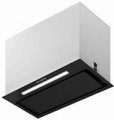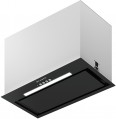Flow of air (extraction)
The performance of the hood in extraction mode at maximum speed shows the real possibilities for air purification. Since this parameter is several times less than the motor performance (maximum performance), not all manufacturers indicate this value, trying to present large and beautiful numbers. A similar situation can be observed among other devices. For example, in vacuum cleaners, the total power is many times greater than the suction power; in acoustics, mediocre brands prefer to list peak power instead of nominal power. Therefore, motor performance and extraction performance can not be compared. However, high-performance motors will also give high performance in extraction mode. And it may well be that the conditional Bosch with an extraction performance of 300 m³/h will be better than another hood with a maximum motor performance of 500 m³/h.
Flow of air (intensive mode)
Extraction flow of the air when using intensive mode. This mode is used in case of emergency on the stove, such as burnt food, spilt liquid, etc., which give off a lot of smoke and an extremely unpleasant smell. In turn, the intensive mode forces the hood to run at maximum speed, thereby increasing its performance even more (compared to performance at maximum speed). However, this function is activated for a short time (so the motor does not burn out). Therefore this mode is not considered standard, and it will not be possible to use it in everyday cooking.
Minimum noise level
The volume at which the device operates in the quietest mode. Usually (but not necessarily) it is the minimum power mode.
The decibels in which the noise level is measured are non-linear units, so it is easiest to use comparison tables to estimate a specific value. Here is the simplest table for minimum noise in modern hoods:
— 20 dB. Almost inaudible. The volume of a whisper at a distance of 1 m, the sound background in an open field on a calm day.
— 30 dB. The whisper, the ticking of the clock. The maximum noise level allowed for residential premises at night.
— 40 dB. The volume of normal human speech. The maximum permissible sound background (permanent) for living quarters during the day.
— 50 dB. Conversation of several people in medium tones.
— 60 dB. Loud talk.
— 65 – 68 dB — background noise on a city street, a vacuum cleaner engine at a distance of 2 – 3 m. The highest noise level among modern hoods is typical for powerful performant models.
When choosing according to this indicator, note that, other things being equal, a quieter device will, accordingly, cost more.
Max. noise level
The level of noise produced by the hood in the loudest mode of operation. Usually (but not necessarily) it is the maximum power mode. It affects the comfort during operation of the device, so
quiet hoods will be more preferable, but also more expensive.
The decibels in which the noise level is measured are non-linear units, so it is easiest to use comparison tables to estimate a specific value. Here is the simplest table for the values relevant in this case:
— 35 dB. The volume of a conversation in an undertone (but not a whisper). The lowest maximum noise value in modern hoods. Devices with such characteristics are almost guaranteed not to cause inconvenience: such noise is often blocked by other sounds, for example, the background noise of the street in an open window.
— 40 dB. The volume of a normal conversation. The maximum noise level allowed in a residential area during the day. If the hood is bought for home use, and it is supposed to be turned on often and for a long time, the noise level in the selected device shouldn't exceed this indicator.
— 50 dB. Conversation volume at medium tones.
— 60 dB. Raised conversation.
— 70 dB. Sound background on a busy street, in a crowd of people talking loudly, the sound of a vacuum cleaner motor at a distance of 2 – 3 m.
— 75 dB. Scream or loud laughter at a distance of about a metre.
— 78 – 79 dB. Loud mechanical alarm clock, motorcycle o
...r truck engine. The highest level in modern consumer-grade hoods.
Note that the actual comfort of using the device depends not only on the volume but also on the timbre (tonality) of the noise: for example, a low, even rumble is generally perceived easier than high frequencies with clanging notes. If the hood installation is unsuccessful, the actual noise level may be higher than stated in the specifications. For example, additional noise can be caused by the hum of air in the ducts or rattling from the contact of the vibrating body with the wall. However, when choosing, it is worth focusing on the noise level claimed in the specifications.Controls
The control method provided in the hood.
—
Push-buttons. The most popular control method in modern hoods can be provided in devices of any functionality and price category — from low-cost models, where buttons directly control the motor, to high-end solutions with advanced electronic circuits.
—
Rotary knobs. Control with rotary knobs, sometimes supplemented by buttons or touch sensors. A rather specific option found mainly in high-end hoods, where rotary knobs are part of the design.
—
Slider. Control using the lever moved on the special panel. Usually, only power is regulated in this way: the farther the slider is from the neutral position, the more air the hood draws. A fairly universal control method, found in hoods of all price categories.
—
Touch controls. Control using touch panels is considered a sign of expensive high-end hoods. It is because it makes sense to use such panels mainly with advanced control electronics and they are poorly suited for low-cost devices. From a practical point of view, the touch controls are remarkable for their ease of use and ease of cleaning: a light touch is enough to give a command, and the panel itself has no slots or protrusions, making it easy to clean dirt.
Remote control
A remote control allows you to control the functions of the hood from a distance. Such a remote control will be especially convenient for those who, due to low height or health problems, find it difficult to reach for the hood itself every time. At the same time, this function affects the cost of the device, and the need for it arises relatively rarely. Therefore, the presence of a
remote control is typical mainly for rather expensive models.
Hob to hood
Compatibility of the hood with
automatic control systems used in some hobs. Such control is carried out as follows: the hob determines how many burners and at what power thy are turned on and sends a control signal to the hood, adjusting its power to the current situation. Thus, the user does not need to adjust the ventilation manually — the kitchen equipment will automatically set the optimal hood mode.
It is worth noting that modern kitchen appliances use several different automatic control technologies. They can even differ in the principle of communication: for example, Miele's Con@Сtivity uses radio frequencies, and Electrolux's Hob2Hood uses infrared channel. Therefore, if you want to assemble a kit with automatic control, you should make sure that both the hood and the hob support the same communication technology. The easiest way to achieve this is to select devices from the same manufacturer.
Energy class
This indicator characterizes how economically the hood consumes electricity. Initially, classes were marked in Latin letters from A (highest) and further down as they went down; later, improved classes A+ and A++ appeared. (the more pluses, the better). More energy-efficient models are more expensive but can pay for themselves in the process of use, especially if you have to cook often and in large quantities.
Height (max)
The height of the entire hood structure is from the lower edge to the upper part of the body (the point of connection of the external air duct). For hoods with an adjustable design that allows you to change the height of the case, the maximum height is the size of the device in the unfolded state; in the case of non-adjustable hoods, this means a correspondingly constant overall height. When choosing a hood in height, it is worth proceeding from two points:
1. The optimal height of the air intake above the hob is 60-80 cm. This height allows the hood to capture kitchen fumes effectively and, at the same time, gives enough space to work with the hob.
2. Between the hood body and the ceiling, a clearance is required for connecting an external air duct.

